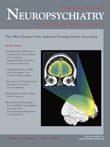Amisulpride-Induced Tardive Dyskinesia and Possible Association of Dyskinesia with Hypothyroidism
To the Editor: Amisulpride, a second generation antipsychotic, is a substituted benzamide derivative that preferentially binds to dopamine D2/D3 receptors in limbic rather than striatal structures. The literature is sparse, with only two case reports of tardive dyskinesia associated with amisulpride. 1 , 2 We report a similar case and also highlight possible interaction of thyroid hormone and dopamine receptors in the emergence of tardive dyskinesia.
Case Report
Mr. S, a 24-year-old single male engineer, was diagnosed with schizophrenia 3 years ago according to ICD-10 criteria. He had good premorbid functioning, with no significant family or personal history of psychiatric and neurological illness. He exhibited predominantly negative symptoms as well as periods of paranoid symptoms. Mr. S consulted a psychiatrist for the first time 6 months after the onset of his illness. He was stabilized on olanzapine, up to 20 mg/day for 2 years, and was later switched to aripiprazole due to significant weight gain. After 4 months of optimal dose of aripiprazole (30 mg/day), however, there was no further improvement in his positive or negative symptomatology. Subsequently, Mr. S was started on amisulpride, 50 mg/day, titrated up to 400 mg/day over 10 weeks. After 15 weeks of amisulpride therapy, he developed dyskinetic finger movements in both hands, predominately involving his right thumb. Although he was aware of the movements, he had no difficulty in carrying out his daily routine activities. When asked to control it, he could suppress these movements only for a few seconds. There were no abnormal movements noticed in other parts of the body. His Abnormal Involuntary Movements Scale (AIMS) score was 9. In view of persistent weight gain and marked negative symptoms, a metabolic panel was obtained, including thyroid function tests. These showed elevated thyroid-stimulating hormone (8.3 mU /liter; normal range =0.4–5.0 mU/liter). Amisulpride was discontinued and it was replaced by clozapine, which was gradually titrated to 75 mg/day along with levothyroxine, 25 mg/day. All dyskinetic movements subsided after 6 weeks of this combined therapy. Subsequent thyroid profile also became normal, and he was continued on clozapine and levothyroxine.
Discussion
The appearance of dyskinesia while on amisulpride and the prompt resolution of dyskinesia after discontinuing amisulpride strongly suggests a case of amisulpride-induced tardive dyskinesia. There has been no information associating tardive dyskinesia and hypothyroidism in patients receiving amisulpride. Hypothyroidism has been associated with subsensitivity of strial dopamine receptors and thyroid hormones potentiate dopaminergic behavior. 3 A study carried out in rats treated with haloperidol revealed significant upregulation of dopamine receptors in hypothyroid rats compared with hyperthyroid rats. 4 Furthermore those psychotropic drugs which generally do not show the tendency to develop tardive dyskinesia such as clozapine, supiride, and nomifensine also exhibited tardive dyskinesia and associated hypothyroidism. 5 – 7 It is possible that thyroid dysfunction interacts with or has some influence on the dopaminergic system as far as emergence of tardive dyskinesia is concerned. This case raises the possibility of underreporting the association of tardive dyskinesia and hypothyroidism and demonstrates a need for further research to answer the queries about the risk factors between hypothyroidism and the emergence of tardive dyskinesia.
1 . Masdrakis VG, Papadimitriou GN, Papageorgiou C, et al: Development of tardive dyskinesia in a patient taking amisulpride. Prog Neuropsychopharmacol Biol Psychiatry 2007; 31:586–587Google Scholar
2 . Fountoulakis KN, Panagiotidis P, Siamouli M, et al: Amisulpride-induced tardive dyskinesia. Schizophr Res 2006; 88:232–234Google Scholar
3 . Goetz CG, Wriner WJ, Klawans HL: Treatment of chorea, in Disorders of Movements. Edited by Bareau A. Lancaster, England, MTP Press, 1989, pp 29–43Google Scholar
4 . Crocker AD, Overstreet DH: Modification of the behavioral effects of haloperidol and dopamine receptor regulation by altered thyroid status. Psychopharmol 1984; 82:102–106Google Scholar
5 . Mendhekar DN, Duggal HS: Clozapine induced tardive dyskinesia and hypothyroidism. J Neuropsychiatry Clin Neurosci 2006; 18:2Google Scholar
6 . Sandyk R: Tardive dyskinesia induced by sulpride in a patient with hypothyroidism. Clin Neuropharmacol 1986; 9:100–101Google Scholar
7 . Sandyk R, Gilman MA: Nomifensive exacerbates orofacial dyskinesia in hypothyroidism. Neurology 1985; 35:282Google Scholar



